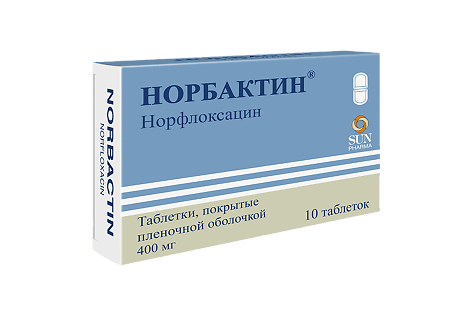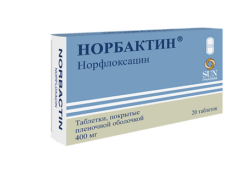No products in the cart.
Norbaktin, 400 mg 10 pcs
€11148.00 €9.29
Description
Pharmacological action – broad spectrum antibacterial (bactericidal).
Pharmacodynamics
An antibacterial agent of the group of fluoroquinolones. It has a bactericidal effect. It affects the bacterial enzyme DNA-gyrase, which provides superspiralization and thus the stability of bacterial DNA. Destabilization of DNA chain leads to the death of bacteria. It has a broad spectrum of antibacterial action.
Sensitive: Staphylococcus aureus (including strains of Staphylococcus spp. resistant to methicillin), Staphylococcus epidermidis, Neisseria gonorrhoeae, Neisseria meningitis, Escherichia coli, Citrobacter spp., Klebsiella spp., Enterobacter spp, Hafnia, Proteus spp. (indole-positive and indole-negative), Salmonella spp., Shigella spp., Yersinis enterocolitica, Campilobacter jejuni, Aeromonas plesiomonas, Vibrio cholerae, Vibrio parahaemolyticus, Haemophilus influenzae, Chlamydia spp., Legionella spp.
Different sensitivity to the drug has: Enterococcus faecalis, Streptococcus spp. (pyogenes, pneumoniae and viridans), Serratio marcescens, Pseudomonas aeruginosa, Acinetobacter, Mycoplasma hominis, Mycoplasma pneumoniae, Mycobacterium tuberculosis, Mycobacterium fortuim.
Intolerant: Ureaplasma urealyticum, Nocardia asteroides, anaerobic bacteria (e.g. Bacteroides spp.,, Peptococcus spp., Peptostreptococcus spp., Eubacterium spp., Fusobacterium spp., Clostridium difficile), Treponema pallidum. Duration of effect – about 12 hours.
Pharmacokinetics
Absorption – 20-40% (food slows down). Tmax in plasma – 1 h. Binding to plasma proteins – 10-15%. Well distributed in the body (renal parenchyma, ovaries, seminal tubules fluid, prostate, uterus, abdominal and pelvic organs, bile, mother’s milk). It penetrates through the BBB and the placenta. It is metabolized in liver to a small extent.
Extracted by the kidneys through glomerular filtration and tubular secretion. Within 24 hours after the dose 32% of it is excreted unchanged by kidneys, 5-8% – as metabolites; about 30% of dose taken is excreted in bile.
Indications
Indications
Treatment of infectious and inflammatory diseases caused by susceptible microorganisms, including:
– urinary tract infections;
– genital tract infections;
– uncomplicated gonorrhea;
– gastrointestinal infections;
– prevention of sepsis in patients with neutropenia;
– traveler’s diarrhea.
Active ingredient
Active ingredient
Composition
Composition
How to take, the dosage
How to take, the dosage
Acute urinary tract infections – 400 mg twice a day for 7-10 days.
Acute uncomplicated cystitis – 400 mg twice a day for 3 days.
Recurrent or chronic urinary tract infections with exacerbations – 400 mg twice a day for 4 weeks and then, if necessary, 400 mg per day for up to 12 weeks.
There is evidence of a significant reduction in the frequency of urinary tract infections recurrence in women with frequent recurrent infections when prophylactic administration of 200 mg Norbaktin once after sexual intercourse.
Chemoprophylaxis in urological interventions, surgeries and postoperative infections – 400 mg twice daily before and after surgery, as required.
Acute uncomplicated gonococcal infections – 800 mg once daily.
Bacterial intestinal infections – 400 mg twice daily for 5 days.
Prevention of travelers’ diarrhea – 400 mg once daily (not more than 21 days). Wide use of antibacterials for diarrhea prophylaxis is not recommended; they may be used in high-risk areas with aggravating factors (hypochlorhydria, use of antacids and secretion inhibitors, dysgammaglobulinemia) and high risk of complications due to dehydration in somatic diseases, taking diuretics, cardiac glycosides.
For better efficacy and tolerability, Norbactin should be taken one hour before or two hours after meals. It should not be taken together with antacids. Patients are recommended to drink enough fluids to prevent crystalluria.
Patients with renal insufficiency (creatinine clearance from 10 to 30 ml/min/1.73m2) – 400 mg once a day.
Interaction
Interaction
Simultaneous use of antacids containing aluminum or magnesium hydroxide, as well as drugs containing iron, zinc, sucralfate reduces absorption of norfloxacin (interval between their administration should be at least 4 hours).
Decreases clearance of theophylline by 25%; therefore, if used concomitantly, theophylline dose should be reduced.
The concomitant administration of norfloxacin with drugs that have the potential to decrease BP may cause a sharp decrease in BP. Therefore, in these cases, as well as when concomitant administration of barbiturates and anesthetics, heart rate, BP and ECG parameters should be monitored.
The concomitant use with drugs that lower the seizure threshold may lead to the development of epileptiform seizures.
Increases the serum concentration of indirect anticoagulants, cyclosporine (reciprocally).
Decreases the effect of nitrofurans.
Special Instructions
Special Instructions
If it is necessary to prescribe Norbaktin® during lactation, discontinuation of breastfeeding should be considered.
During treatment with the drug, patients should get enough fluids (under diuresis control).
An increase in prothrombin index has been noted during therapy with norfloxacin.
The clotting system should be monitored during surgical interventions.
At the time of treatment with Norbaktin® exposure to direct sunlight should be avoided.
In case of tendon pain or at first signs of tendovaginitis, it is recommended to discontinue the drug.
Impact on the ability to drive vehicles and operate machinery. Due to the possible occurrence of dizziness, patients taking Norbaktin® should be careful when driving and engaging in other potentially hazardous activities requiring increased attention and rapid psychomotor reactions (especially if alcohol is also consumed)/
Patients taking Norbaktin® should be careful when driving and engaging in other potentially hazardous activities requiring increased attention and rapid psychomotor reactions.
Contraindications
Contraindications
– hypersensitivity to norfloxacin or other drugs from the group of fluoroquinolones;
– deficiency of glucose-6-phosphate dehydrogenase;
– atherosclerosis of cerebral vessels;
– cerebral circulation disorder;
– epilepsy, seizure syndrome;
– renal/liver failure;
– pregnancy;
– lactation period;
– childhood and adolescence (under 18).
Side effects
Side effects
Digestive system disorders: anorexia, bitter taste in the mouth, nausea, vomiting, abdominal pain, diarrhea, pseudomembranous enterocolitis (in long-term use), increased liver transaminases activity.
Urinary system disorders: crystalluria, glomerulonephritis, dysuria, polyuria, albuminuria, urethral bleeding, hypercreatininemia.
Nervous system disorders: headache, dizziness, insomnia, hallucinations.
Cardiovascular system disorders: tachycardia, arrhythmias, decreased BP, syncope, vasculitis.
Allergic reactions: skin itching, urticaria, edema, Stevens-Johnson syndrome.
Musculoskeletal system disorders: arthralgia, tendinitis, tendon ruptures.
Hematopoietic disorders: leukopenia, eosinophilia, decrease in hematocrit.
Others: candidiasis.
Overdose
Overdose
Symptoms (3 g per 45 min): dizziness, nausea, vomiting, drowsiness, cold sweat, puffy face without changes in basic hemodynamic parameters.
Treatment: gastric lavage, adequate hydration therapy with forced diuresis. Examination and observation in the hospital for several days is required.
There is no specific antidote.
Similarities
Similarities
Additional information
| Weight | 0.020 kg |
|---|---|
| Shelf life | 3 years |
| Conditions of storage | In a dry place, at a temperature not exceeding 25 °C |
| Manufacturer | Sun Pharmaceutical Industries Ltd, India |
| Medication form | pills |
| Brand | Sun Pharmaceutical Industries Ltd |
Other forms…
Related products
Buy Norbaktin, 400 mg 10 pcs with delivery to USA, UK, Europe and over 120 other countries.
















